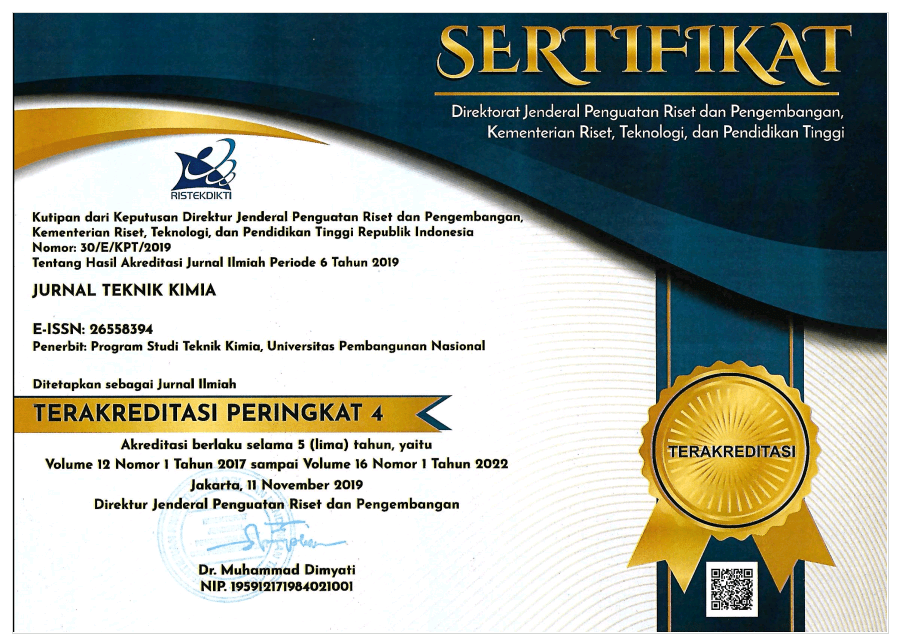TEMPERATURE AND ACETIC ACID CONCENTRATION OPTIMATION IN THE EPOXIDATION REACTION OF PALM OIL METHYL ESTER
Abstract
Vegetable oils are rich in content unsaturated fatty acid from the type of oleic acid, linoleic acid and
linolenic acid that can be converted to epoxide groups. Epoxidized oil has many useful applications such as
plastisizer to improve flexibility, elasticity and stability under the influence of heat and radiation. In this
research, palm oil was converted first to become palm oil methyl ester (POME), followed by epoxidation
reaction to produce epoxidized palm oil methyl ester (EPOME). Response surface method (RSM) was performed
for optimization and to study the influence of reaction temperature and molar ratio
POME/CH3COOH on the conversion reaction and oxirane value. An optimal reactional condition was shown
by high oxirane content which was in the form of oxirane counts/number. Epoxidation reaction was run in
the batch reactor using acetic acid as an oxygen carrier. Central Composite Design (CCD) with two independent
variables and two response function was utilized to investigate the effect of input variables. The
result shows that reaction conversion increased with the rise of reaction temperature and molar ratio of
POME/CH3COOH before reaching the maximum point, and then it monotonously decreased. The optimal
operating condition for epoxidation reaction was indicated by maximum oxirane value which could be
reached by the reaction temperature of 56.3 oC and molar ratio POME/CH3COOH of 1:0.43
Key words: epoxidation, methyl ester, oxirane, palm oil
linolenic acid that can be converted to epoxide groups. Epoxidized oil has many useful applications such as
plastisizer to improve flexibility, elasticity and stability under the influence of heat and radiation. In this
research, palm oil was converted first to become palm oil methyl ester (POME), followed by epoxidation
reaction to produce epoxidized palm oil methyl ester (EPOME). Response surface method (RSM) was performed
for optimization and to study the influence of reaction temperature and molar ratio
POME/CH3COOH on the conversion reaction and oxirane value. An optimal reactional condition was shown
by high oxirane content which was in the form of oxirane counts/number. Epoxidation reaction was run in
the batch reactor using acetic acid as an oxygen carrier. Central Composite Design (CCD) with two independent
variables and two response function was utilized to investigate the effect of input variables. The
result shows that reaction conversion increased with the rise of reaction temperature and molar ratio of
POME/CH3COOH before reaching the maximum point, and then it monotonously decreased. The optimal
operating condition for epoxidation reaction was indicated by maximum oxirane value which could be
reached by the reaction temperature of 56.3 oC and molar ratio POME/CH3COOH of 1:0.43
Key words: epoxidation, methyl ester, oxirane, palm oil

This work is licensed under a Creative Commons Attribution 4.0 International License.
Copyright @ 2006 Jurnal Teknik Kimia -Program Studi Teknik Kimia - Universitas Pembangunan Nasional "Veteran" Jawa Timur
______________________________________________________________________
Pusat Publikasi | Teknik Kimia | Fakultas Teknik (Gedung Giri Reka ) | Universitas Pembangunan Nasional "Veteran" Jawa Timur, Indonesia
Jln. Raya Rungkut Madya, Gunung Anyar Surabaya, 60294 Email : jurnaltekkim@upnjatim.ac.id








